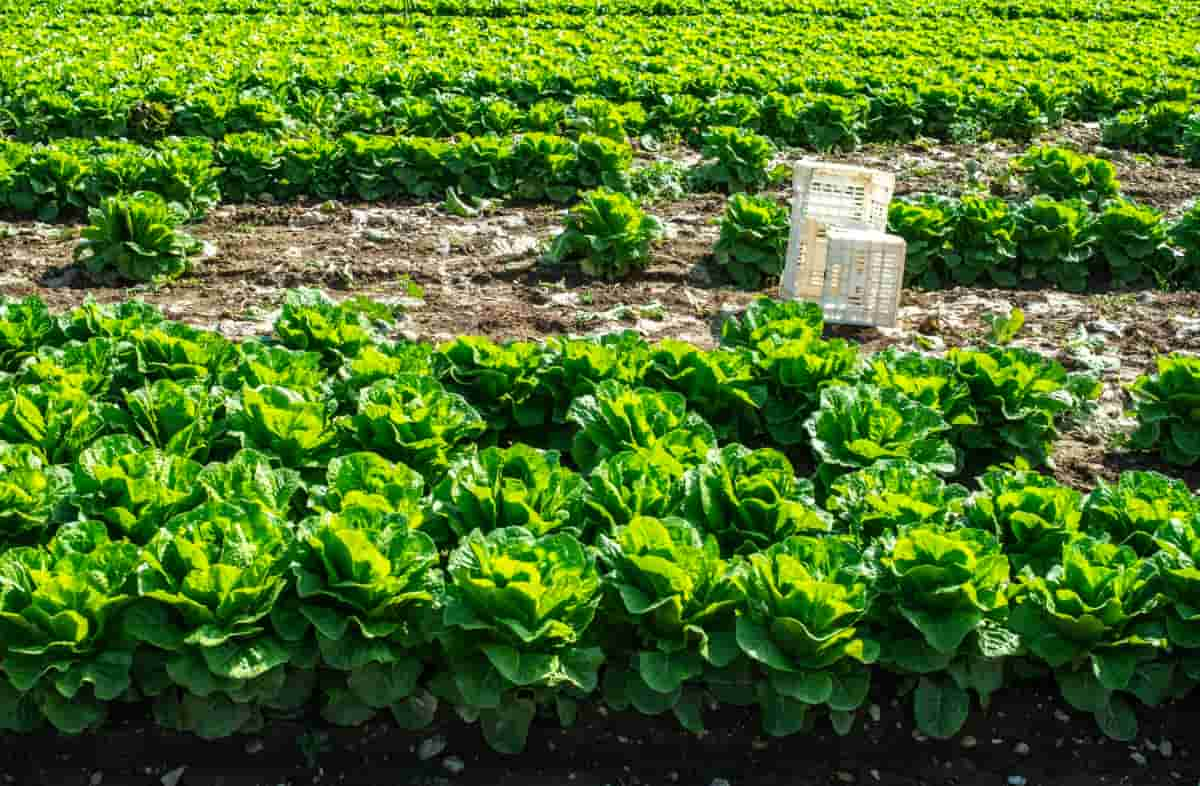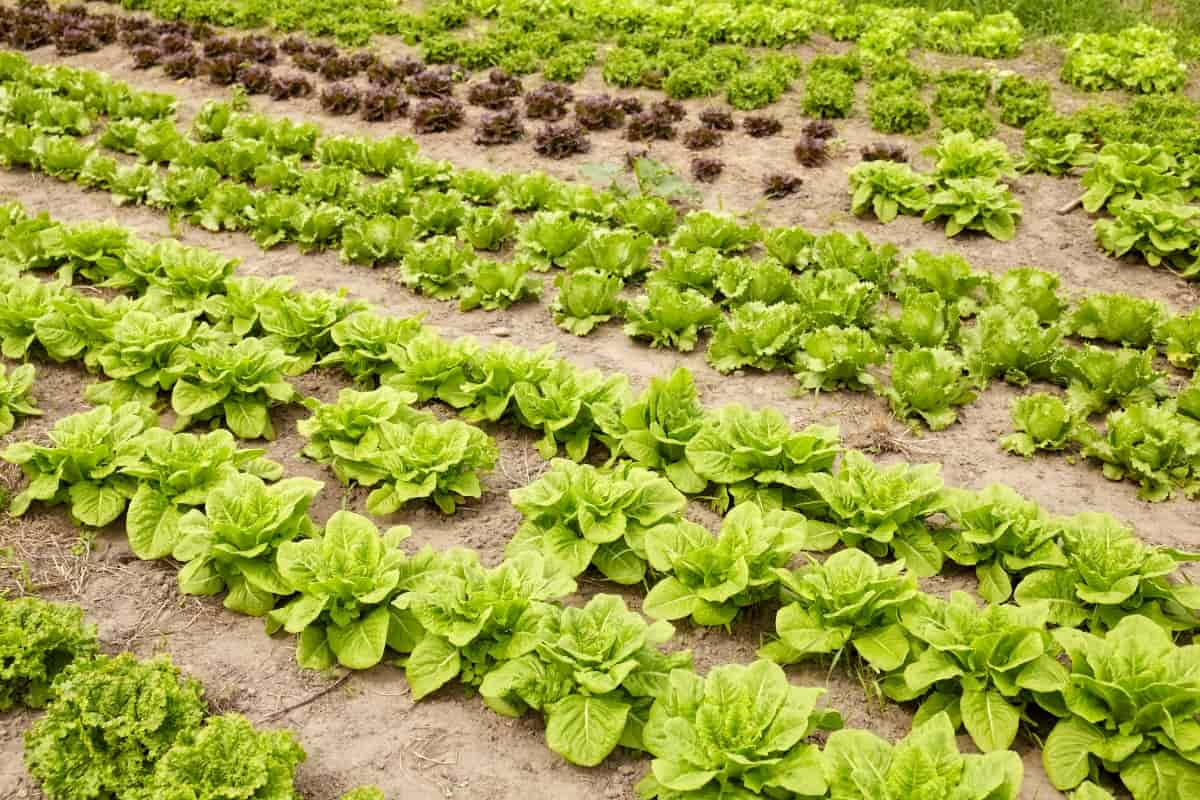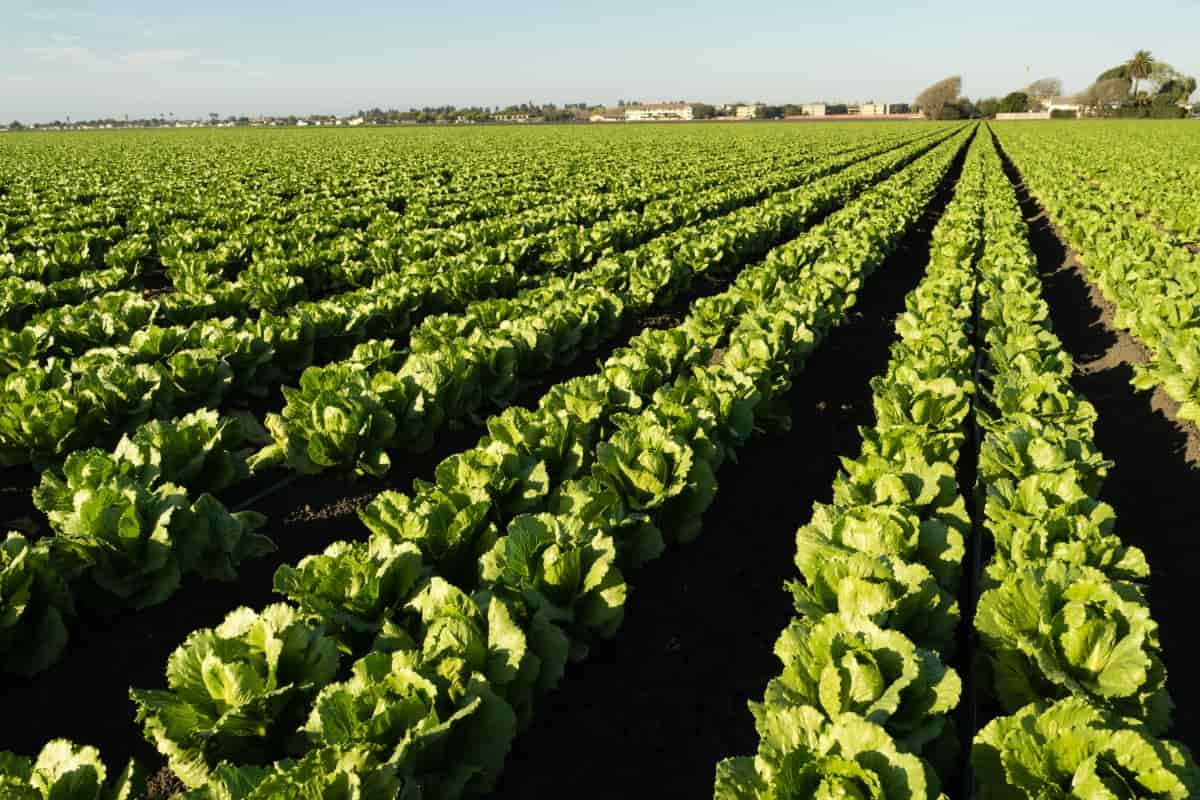Lettuce, scientifically known as Lactuca sativa, belongs to the family Asteraceae. However, Lettuce can be grown for its stems and seeds, making it a highly valuable crop. Lettuce farming in India offers numerous benefits ranging from high market demand to low investment costs compared to other crops. With suitable climate conditions and proper cultivation techniques, farmers can achieve profitable yields with this versatile leafy green vegetable.

Lettuce Farming in India
This leafy green vegetable is delicious and also highly nutritious, making it a favorite among health-conscious individuals. In recent years, the Lettuce market in India has witnessed significant growth. Additionally, with more people embracing international cuisines, Lettuce has become an essential ingredient in salads and sandwiches.
Climate and Soil Requirements for Lettuce Farming in India
Lettuce is a cool-season crop that prefers moderate temperatures, making it suitable for regions with mild winters and relatively cooler summers. Ideally, Lettuce thrives in temperatures between 16 to 24°C. When it comes to soil requirements, well-drained, loamy soils are considered ideal for Lettuce cultivation. Soil pH level from 6 to 7 is optimal for healthy growth and development of Lettuce plants.
Varieties of Lettuce Suitable for Indian Conditions
One popular Lettuce variety in India is the Iceberg Lettuce variety, best for its crisp texture and mild flavor. Another option is Romaine Lettuce, which has elongated dark green color leaves and a bitter taste. This variety can withstand heat better than others. If you prefer leaf Lettuces, there are plenty of options too.
Red leaf Lettuce adds color to your garden with its vibrant red foliage. Green leaf Lettuce, on the other hand, offers a milder flavor and tender leaves that are perfect for wraps or garnishes. For those looking to grow Lettuce all year round, consider loose-leaf varieties like Butterhead or Bibb Lettuce. Remember to choose varieties based on your local climate and growing conditions.
Step-By-Step Guide to Farming Lettuce in India’s Varied Climates
You need to select the right variety of Lettuce suitable for your region. Some popular varieties include Iceberg, Romaine, and Butterhead Lettuce. Each variety has its unique growing requirements. Next, prepare the growing soil by loosening it and removing any weeds or debris. Lettuce thrives in well-drained soil with a pH level between 6.0 and 7.0.
Sow the seeds directly into prepared seedbeds at a depth of about a quarter an inch (0.5 cm). Keep the bed moist, but avoid overwatering as excessive moisture can lead to fungal diseases. Once seedlings emerge after about one week, thin them out so that each plant has enough space for proper growth, depending on the variety. Regular watering is essential throughout the growing period. Harvesting time varies based on Lettuce type but generally falls within 40-70 days after sowing.
Lettuce Seed Germination and Sowing Time India
Germinating Lettuce seeds is an important step in the Lettuce farming process. To ensure successful germination, it’s crucial to provide the right conditions for the seeds to sprout. Selecting good quality seeds is essential. Look for reputable suppliers who offer high-quality Lettuce seeds that are disease-free and have a high germination rate.
In case you missed it: Oak Leaf Lettuce Overview: History, Origin, Varieties, Nutritional Benefits and Growing Tips

Soaking the seeds before sowing can help speed up germination. You can soak them in water overnight or for a few hours until they swell up. This will soften the seed coat and aid in quicker sprouting. Sowing time varies depending on the region and climate of India. In cooler regions like northern India, early spring or fall is the ideal time for sowing Lettuce seeds, as they prefer milder temperatures.
Organic Lettuce Farming Practices in India
The key aspect of organic Lettuce farming in India is soil management. Farmers use compost or well-rotted manure to enrich the soil and improve its structure. Crop rotation is another important practice followed in organic Lettuce farming. By rotating crops, farmers can prevent the buildup of pests and diseases specific to Lettuce plants. In organic Lettuce farming, biological control methods are preferred over chemical insecticides to manage pests effectively.
Natural predators (ladybugs and parasitic wasps) are encouraged on farms as they feed on harmful insects that attack Lettuce plants. To avoid nutrient deficiencies, organic farmers focus on providing balanced nutrition through natural sources like neem cake, bone meal, seaweed extracts, etc., promoting healthier plants while minimizing environmental impact.
Lettuce Farming Cost Per Acre
The cost per acre for Lettuce farming in India varies based on many factors, such as seed selection, soil preparation, irrigation methods, fertilizers, labor costs, and pest control measures. Considering all these factors combined with proper farm management practices will help determine accurate estimates of Lettuce farming costs per acre in India.
| Cost Item | Estimated Cost (Per Acre) in INR |
| Seed Cost | |
| Quantity Required | 1 to 1.2 kg |
| Cost per kg | ₹ 300 – ₹ 500 |
| Land Preparation | ₹ 2,000 – ₹ 3,000 |
| Fertilization | |
| Farmyard Manure (15-20 tonnes/ha) | ₹ 10,000 – ₹ 15,000 |
| Nitrogen (25 kg/ha) | ₹ 500 – ₹ 1,000 |
| Potassium (25 kg/ha) | ₹ 500 – ₹ 1,000 |
| Phosphorus (90 kg/ha) | ₹ 1,500 – ₹ 2,500 |
| Irrigation | ₹ 1,500 – ₹ 3,000 |
| Labor (Planting, Weeding, Harvesting) | ₹ 5,000 – ₹ 8,000 |
| Pest and Disease Control | ₹ 1,000 – ₹ 2,000 |
| Miscellaneous Costs | ₹ 1,000 – ₹ 2,000 |
| Total Estimated Cost | ₹ 22,300 – ₹ 35,000 |
Lettuce Farming Profit Per Acre
Lettuce farming can be a profitable venture for farmers in India. The Lettuce profit per acre in India depends on many factors, such as market demand, yield, and production costs. To maximize profitability in Lettuce farming, it’s recommended that farmers adopt organic farming practices that reduce input costs while catering to the rising demand for chemical-free produce.
| Item | Amount |
| Revenue | |
| Average Yield per Acre | 4,000 – 5,000 kg (average) |
| Market Price per Kg | ₹ 20 – ₹ 30 |
| Total Revenue (Avg.) | ₹ 80,000 – ₹ 150,000 |
| Costs (from the previous table) | |
| Total Estimated Cost | ₹ 22,300 – ₹ 35,000 (See the cost table) |
| Profit | |
| Gross Profit (Revenue – Costs) | ₹ 57,700 – ₹ 115,000 |
Lettuce Yield Per Acre
The yield determines the profitability of the venture and helps in estimating the potential returns. The Lettuce yield per acre in India can change based on various factors such as climate, soil conditions, cultivation practices, and crop management techniques. On average, a well-managed Lettuce farm can produce around 4,000 – 5,000 kg (average) of Lettuce per acre.
Market Demand for Lettuce in India
Lettuce, with its crisp and refreshing qualities, has gained immense popularity among health-conscious consumers in India. The increasing demand for organic or natural produce has contributed to the rise in Lettuce consumption across the country. The urban population, especially millennials and fitness enthusiasts, are driving this trend due to their focus on maintaining a healthy lifestyle.
In case you missed it: All About Little Gem Lettuce: Growing from Seeds, Uses, Benefits, Size, Weight, Price, Origin, and History

Furthermore, the export market presents significant opportunities for Lettuce farmers in India. As awareness about Indian-grown vegetables increases globally, there is a rising demand for high-quality Lettuce from international markets. To meet this surging demand both domestically and internationally, farmers need to adopt efficient cultivation practices that ensure a consistent supply of fresh Lettuce throughout the year.
Lettuce Crop Duration and Planting Season in India
In regions with mild winters, such as Northern India, Lettuce can be grown during the winter months from October to February. For areas with hot summers, like Southern India, it is best to grow Lettuce during the cooler months of September to January. To extend the growing season, farmers can utilize techniques like shade netting or mulching to protect the plants from excessive heat and maintain soil moisture levels. The duration from sowing to harvest varies based on variety but typically ranges from 45-70 days for leafy types and up to 90 days for head types of Lettuce.
Lettuce Companion Plants
- Radishes: Planting radishes alongside Lettuce helps deter pests like aphids and flea beetles while also improving the texture of the soil.
- Carrots: Carrots make excellent companions for Lettuce as they do not compete for nutrients or space.
- Marigolds: These flowers add beauty to your garden and also act as natural repellents against nematodes and other harmful insects that may attack your Lettuce crop.
- Chives: Planting chives near Lettuce can help repel aphids due to their strong scent. Additionally, chives aid in attracting pollinators like bees to ensure proper fertilization of the crops.
In case you missed it: Buttercrunch Lettuce: Growing Stages, and How to Grow in Containers and the Ground

Conclusion
Lettuce farming is gaining popularity in India due to its several benefits and the increasing demand for fresh, healthy produce. It provides a sustainable income source for farmers in India. With the demand for fresh produce in urban areas, cultivating Lettuce can be a profitable venture.
- Feed Your Flock for Less: Top 10 Tips to Save on Chicken Feed
- Ultimate Guide to Ossabaw Island Hog: Breeding, Raising, Diet, and Care
- Hatching Answers: The Top 10 Reasons Your Chickens Aren’t Laying Eggs
- Eggs and Economics: Breaking Down the Cost of Raising Backyard Chickens
- Defend Your Greens: Proven Methods to Keep Iguanas Out of Your Garden
- Ultimate Guide to Cinnamon Queen Chicken: A Comprehensive Guide for Beginners
- Ultimate Guide to California Tan Chicken: Breeding, Raising, Diet, Egg-Production and Care
- Ultimate Guide to Marsh Daisy Chicken: Breeding, Raising, Diet, and Care
- 10 Types of Chicken Farming Businesses You Can Start for Profits